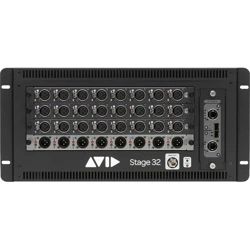Loading ...
Loading ...
Loading ...

Events 302
Events
An event consists of one or more triggers, which are configured to cause one or more actions to occur.
Events can be very simple, such as the press of a Function switch enabling a Mute Group, or the press of a connected footswitch
triggering a Recall Next Snapshot. These are examples of a single specific trigger (a press of a specific Function switch or the press
of a footswitch) causing a single action (enabling a Mute Group or Recall Next Snapshot).
Events can also be quite complex and involve multiple triggers and actions. For example, a single event can be defined so that mov-
ing a specific fader above and/or below a certain level sends a General Purpose output, and recalls a specific snapshot and mutes
one or more channels. Multiple triggers can be considered conditionally using the available logic operators AND, OR, and XOR.
Events can be defined to operate on specific channels, or to operate globally using the “Any...” Triggers and “Triggered....” Ac-
tions.
Any...Triggers
Many sub-menus in the Triggers menu include choices for Any Aux, Any Group, Any Matrix, Any Mains, and Any
VCA (when relevant). Any Strip refers to any input, output, or bus. Any Channel refers to Input Channels only. These let you define
triggers that fire whenever the defined criteria is met on any strip, channel type, or channel.
Triggered Strip Actions
Similarly, many sub-menus in the Actions menu provide the choice for Triggered Strip. Choosing Trig-
gered Strip creates an action that is applied to the input, output, or bus on whichever strip triggered the Event.
Each event can have between 0 and 8 triggers, and each event can have between 0 and 8 actions. Up to 999 events can be created.
The Event list is easy to configure, and pre-configured events are provided to change View Mode on the external screen.
Ter minology
Event
A user-defined combination of one or more triggers and one or more actions. Each event serves as a type of software “macro”
in which you establish a cause-and-effect relationship between one or more triggers and their results (actions).
Trigger
A conditional check used to fire an event, such as the press of a Function switch. Other available Triggers include fader
above/below, meter values, time of day, and MIDI.
Action
A command, mode or other response resulting from an event being triggered.
Control (Continuous)
A variable control such as a fader or knob.
Control (Switch)
A two-state control such as most switches on the control surface.
System Values
Variables such as Fader Above or Below, and system response values such as channel meters and dynamics gain
reduction meters.
GPI
General Purpose Interface, also known as a logic interface. The S6L control surface provides 2 GPI inputs and 2 GPI outputs.
Open
GPI input or GPI output is floating, or at its reference voltage. Or, a Gate is open.
Closed
GPI input or GPI output is closed. Or, a Gate is closed.
Footswitch
Footswitch ports are functionally identical to GPI inputs and share all of the same properties and behaviors.
Properties
The criteria that define triggers and actions. Properties can be edited for many, but not all types of triggers and actions.
Important Information about Snapshots and Events
Because events can trigger snapshot recalls, and because snapshot recalls can trigger other events, it is possible to create logic
“feedback loops.” For more information, see Avoid Feedback Loops.
For more information on the default events and other examples, see
Default Settings, Templates and Examples.
Loading ...
Loading ...
Loading ...
